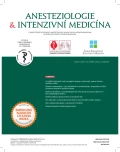Sterility of lidocaine syringes prepared in advance in the obstetric theatre
Authors:
M. Beneš 1; J. Peštová 2; J. Bláha 1
Authors‘ workplace:
Klinika anesteziologie, resuscitace a intenzivní medicíny, 1. lékařská fakulta Univerzity Karlovy a Všeobecná fakultní nemocnice v Praze
1; Ústav imunologie a mikrobiologie, 1. lékařská fakulta Univerzity Karlovy a Všeobecná fakultní nemocnice v Praze
2
Published in:
Anest. intenziv. Med., 29, 2018, č. 2, s. 82-85
Category:
Overview
Objective:
Due to its fast onset of action, 2% lidocaine is our local anaesthetic of choice for topping-up an already established epidural catheter in case of urgent Caesarean Section. Unfortunately, 2% lidocain is only available in 2-ml ampoules in the Czech Republic, and the time needed for drawing up the epidural bolus can be a barrier for its use in emergency. Pre-filled syringes of lidocaine would significantly shorten the time from decision to administration in this situation as well as the overall time of onset of epidural anaesthesia. The general local protocols are mostly against this method, pointing to a risk of bacterial contamination of pre-drawn drugs. Our study had the objective to evaluate the sterility and safety of the pre-filled lidocaine syringe, ready for immediate use in the obstetric theatre.
Design:
Observational, prospective study.
Setting:
Obstetric operating theatre.
Materials and methods:
In total, 59 samples of lidocaine 2%, which were sterilely drawn up from 2-ml ampoules to a 20-ml syringe and closed with a sterile cap, were left on the anaesthetic trolley for 48 hours, and then tested for sterility.
Results:
Microbial or fungal growth was found in none of the 59 pre-filled syringes of 2% lidocaine. All the samples were assessed as suitable from the sterility point of view.
Conclusion:
Local anaesthetics have their own antimicrobial activity against a broad spectrum of pathogens. A sterilely pre-filled lidocaine syringe remains safe for use for at least 48 hours. Pre-filling lidocaine for epidural top-up of anaesthesia for the Caesarean Section is rational and safe in terms of sterility.
Keywords:
lidocaine – sterility – obstetric operating theatre – top-up epidural anaesthesia
Sources
1. Bláha J, Nosková P, Klozová R, et al. Současné postupy v porodnické anestezii III – regionální anestezie u císařského řezu. Anesteziologie a intenzivní medicína. 2014;25:29–39.
2. Hillyard SG, Bate TE, Corcoran TB, et al. Extending epidural analgesia for emergency Caesarean section: a meta-analysis. Br J Anaesth. 2011;107:668–678.
3. Malhotra S, Yentis SM, Lucas N. Extending epidural analgesia for emergency caesarean section. Br J Anaesth. 2012;108:879–880; author reply 880–871.
4. Bláha J, Kolníková I, Nosková P. Císařský řez, ale jaká anestezie? Prakt Gyn. 2011;15:187–191.
5. Aydin ON, Eyigor M, Aydin N. Antimicrobial activity of ropivacaine and other local anaesthetics. Eur J Anaesthesiol. 2001;18:687–694.
6. Sakuragi T, Ishino H, Dan K. Bactericidal activity of clinically used local anesthetics on Staphylococcus aureus. Reg Anesth. 1996;21:239–242.
7. Parr AM, Zoutman DE, Davidson JS. Antimicrobial activity of lidocaine against bacteria associated with nosocomial wound infection. Ann Plast Surg. 1999;43:239–245.
8. Noda H, Saionji K, Miyazaki T. [Antibacterial activity of local anesthetics]. Masui. 1990;39:994–1001.
9. Leung YW, Rawal BD. Mechanism of action of tetracaine hydrochloride against Pseudomonas aeruginosa. J Infect Dis. 1977;136:679–683.
10. Driver RP, Jr, Snyder IS, North FP, Fife TJ. Sterility of anesthetic and resuscitative drug syringes used in the obstetric operating room. Anesth Analg. 1998;86:994–997.
11. Pate DA, Shimizu I, Akin R, Snodgrass K, Emrick A. Safety of prefilled buffered lidocaine syringes with and without epinephrine. Dermatol Surg. 2016;42:361–365.
12. Alam M, Waldman A. Commentary on safety of prefilled buffered lidocaine syringes with and without epinephrine. Dermatol Surg. 2016;42:366–367.
13. Souhrn údajů o přípravku Lidocain, sp. zn. sukls57676/2015. 2015.
Labels
Anaesthesiology, Resuscitation and Inten Intensive Care MedicineArticle was published in
Anaesthesiology and Intensive Care Medicine

2018 Issue 2
Most read in this issue
- The role of videolaryngoscopy in perioperative medicine
- Sleep endoscopy – a new challenge for the anaesthetist in the diagnostics and treatment of the obstructive sleep apnea syndrome
- Impact of adrenaline on the intra-arrest haemodynamics during experimental cardiac arrest
- Echocardiography accrediation for intensivists: The European Diploma in Echocardiography (EDEC)
